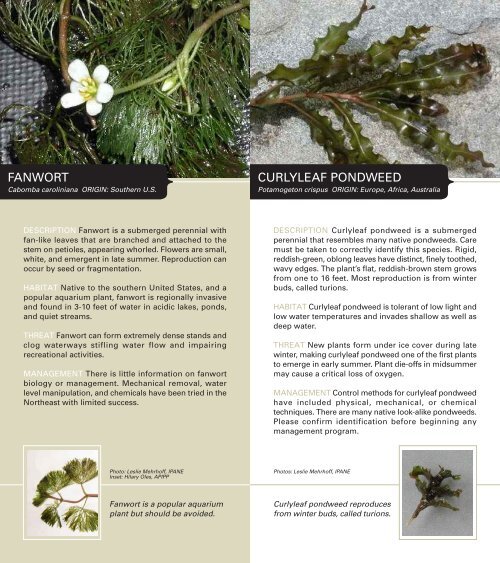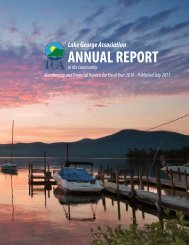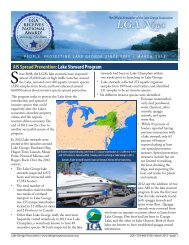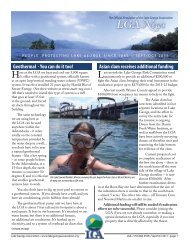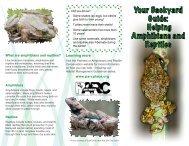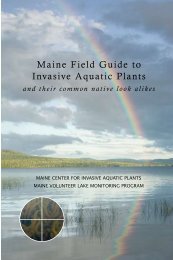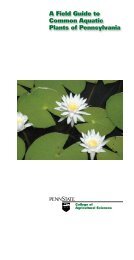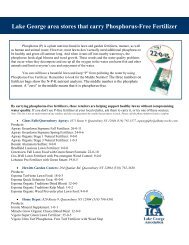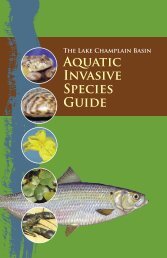Invasive Plants of the Adirondacks - Adirondack Park Invasive Plant ...
Invasive Plants of the Adirondacks - Adirondack Park Invasive Plant ...
Invasive Plants of the Adirondacks - Adirondack Park Invasive Plant ...
Create successful ePaper yourself
Turn your PDF publications into a flip-book with our unique Google optimized e-Paper software.
FANWORT<br />
Cabomba caroliniana ORIGIN: Sou<strong>the</strong>rn U.S.<br />
CURLYLEAF PONDWEED<br />
Potamogeton crispus ORIGIN: Europe, Africa, Australia<br />
DESCRIPTION Fanwort is a submerged perennial with<br />
fan-like leaves that are branched and attached to <strong>the</strong><br />
stem on petioles, appearing whorled. Flowers are small,<br />
white, and emergent in late summer. Reproduction can<br />
occur by seed or fragmentation.<br />
HABITAT Native to <strong>the</strong> sou<strong>the</strong>rn United States, and a<br />
popular aquarium plant, fanwort is regionally invasive<br />
and found in 3-10 feet <strong>of</strong> water in acidic lakes, ponds,<br />
and quiet streams.<br />
THREAT Fanwort can form extremely dense stands and<br />
clog waterways stifling water flow and impairing<br />
recreational activities.<br />
MANAGEMENT There is little information on fanwort<br />
biology or management. Mechanical removal, water<br />
level manipulation, and chemicals have been tried in <strong>the</strong><br />
Nor<strong>the</strong>ast with limited success.<br />
DESCRIPTION Curlyleaf pondweed is a submerged<br />
perennial that resembles many native pondweeds. Care<br />
must be taken to correctly identify this species. Rigid,<br />
reddish-green, oblong leaves have distinct, finely too<strong>the</strong>d,<br />
wavy edges. The plant’s flat, reddish-brown stem grows<br />
from one to 16 feet. Most reproduction is from winter<br />
buds, called turions.<br />
HABITAT Curlyleaf pondweed is tolerant <strong>of</strong> low light and<br />
low water temperatures and invades shallow as well as<br />
deep water.<br />
THREAT New plants form under ice cover during late<br />
winter, making curlyleaf pondweed one <strong>of</strong> <strong>the</strong> first plants<br />
to emerge in early summer. <strong>Plant</strong> die-<strong>of</strong>fs in midsummer<br />
may cause a critical loss <strong>of</strong> oxygen.<br />
MANAGEMENT Control methods for curlyleaf pondweed<br />
have included physical, mechanical, or chemical<br />
techniques. There are many native look-alike pondweeds.<br />
Please confirm identification before beginning any<br />
management program.<br />
Photo: Leslie Mehrh<strong>of</strong>f, IPANE<br />
Inset: Hilary Oles, APIPP<br />
Photos: Leslie Mehrh<strong>of</strong>f, IPANE<br />
Fanwort is a popular aquarium<br />
plant but should be avoided.<br />
Curlyleaf pondweed reproduces<br />
from winter buds, called turions.


